We are always reading four or five books at a time and we pay attention to recommendations we get, when we get them and why.
That said, we don’t try to over-analyze and dissect the meaning behind why a particular book showed up in our lives, but we feel into the alignment, trust and then just start reading. Messages from your spirit guides are a bit like that too when you’re paying attention.
Some strike that up to intuition or coincidence, but simply put: intuition is in fact your Higher Self trying to get a message to you and guides are simply there to assist.

We have begun to push out more videos for our Blue Soul Wisdom video series which includes citing extracts and passages from renowned spiritual authors and other less known ones as well. Take a look at our Blue Soul Wisdom episodes as we’ve covered some of the books we’ve reviewed in the past. Here are several new ones that have showed up on our doorstep that we have already started reading and diving into — feel an alignment with one or more of them? Then, perhaps its time to give it a read.
The Rumi Collection
Even if you’re not on a spiritual path, you’ve likely heard of Rumi – his quotes are scattered across Instagram and not just on spiritually-focused accounts either. We love his quotes and teachings and as University of North Caroline Professor Carl W. Ernst says “the poetry of Rumi is an immense treasure of jewels.” Hear hear.
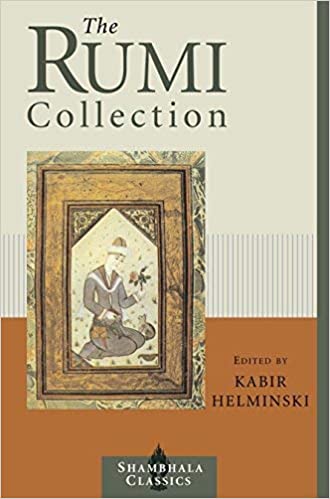
The book is edited by Kabir Helminski, a name we know well because we listen to him live every year at SAND and have for years. See our coverage of SAND from last year which includes the sessions of Kabir Helminski, who beautifully wove Rumi into the teachings.
In the book, they speak of Placelessness and the guides we channel also speak to this, calling it the VOID and that even in the VOID there’s love. What are the ways to get there? Meditation, mantras, prayers or silent walking can all work as can chants, music and sitting in nature. He writes “there is more to the pronouncement of faith than what is said with the tongue because it too has a beginning and an end. Anything that can be vocalized and has a beginning and an end is a “form”, a “shell” — its soul, however, is unqualifiable and infinite, without a beginning and an end.”
Later he writes “We know then that the ‘soul’ of prayer is not only its external form” but also a state of total absorption and unconsciousness during which all these external forms, for which there is no room, remain outside.”
Beautifully said right?
Translators in the book include Coleman Barks, Robert Bly, Andrew Harvey, Kabir and Camille Helminski, Daniel Liebert and Peter Lamborn Wilson. Those not familiar with Rumi? He was a master of the Sufi tradition (1207-1273), which is the mystical branch of Islam. In his poetry, Rumi calls to us from beyond the concerns of institutional religion and limiting beliefs — and this is why there is controversial views about Rumi in the east as well. I would liken that fear or concern the same one that the Catholic Church had and of course why the Gnostic Gospels and writings are also so controversial. See below.
Kabir Helminski, who we mentioned above, speaks at the SAND Conference every year, is what is referred to as a Shaikh, or master, of the Mevlevi Order founded by Rumi and apparently the only Westerner to hold this title. He also wrote Living Presence and The Knowing Heart.
Find Helminski’s ‘The Rumi Collection’ on Amazon.
Women of Sufism
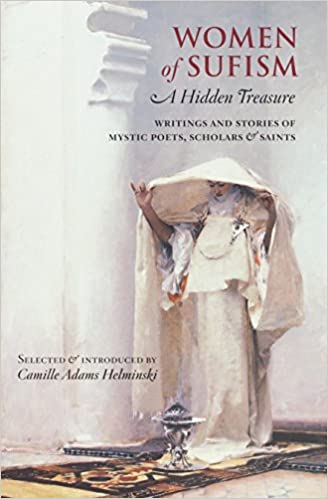 While we’re on Sufism, this elegant book talks about the luminous presence of women who follow the Sufi Way—the mystical path of Islam. What I love about this book so far is that it brings to life their dreams and visions through their sacred songs and poetry. We also hear about the efforts of these women as they witness the Truth in many realms.
While we’re on Sufism, this elegant book talks about the luminous presence of women who follow the Sufi Way—the mystical path of Islam. What I love about this book so far is that it brings to life their dreams and visions through their sacred songs and poetry. We also hear about the efforts of these women as they witness the Truth in many realms.
These writings reflect the honor and respect for the feminine in the Sufi worldview, and they are shared in the spirit of inspiration and hope for the flourishing contributions of women to the spiritual development of humanity.
At a time when the infusion of feminine beliefs and heart-centered work is needed to re-balance humanity the world more than ever, there couldn’t be a better time to know about this book and to read it cover-to-cover.
The book spans the centuries, from the time of the Prophet Muhammad to the present day, and you learn about Sufi traditions in different parts of the world, from Asia, Africa, and the Middle East to Europe and America—from members of the Prophet’s family to the mystic Rabi’a al-Adawiyya to the modern scholar Annemarie Schimmel.
It’s such a wonder and must read book — A Hidden Treasure is its subtitle which is perfectly appropriate as it so thoroughly captures the writings and stories of mystic poets, scholars and saints. Biographical anecdotes and personal memoirs also give you hidden insights into their lives and beliefs but you also get a wonderful introduction to the principles and practices of Sufism as well.
Find it on Amazon.
The Books of Enoch: The Angels, The Watchers & the Nephilim
Now if you Google Book of Enoch or Books of Enoch, you’ll get several books and explanations. According to Wikipedia, which isn’t always correct of course, the Book of Enoch is an ancient Hebrew apocalyptic religious text, ascribed by tradition to Enoch, the great-grandfather of Noah apparently. 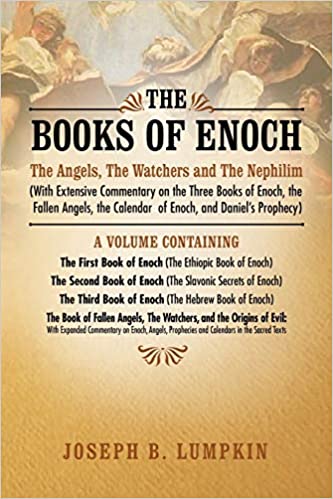
Written in Genesis (Genesis 5:21–24), we learn that Enoch lived 365 years before he was ‘taken by God.’ According to some Jewish and Christian traditions, it was interpreted as Enoch “entering Heaven alive.” I laugh at this because the Ascended Masters we channel talk about the human existence being more dead than alive.
Be that as it may, there have been various books out with their own interpretations and Joseph B. Lumpkin is one, which fell on our radar recently.
As someone who has written about the Gospel of Thomas, the Lost Books of the Bible, Philip, Magdalene and Thomas, the Gnostics and more, we were curious what he had to say.
In this book, Lumpkin strings together a historical narrative of Fallen Angels, the Watcher, and the Nephilim, using his own knowledge and interpretation of these ancient texts. We learn about the Calendar of Enoch and its pivotal place in the prophecy of Daniel. Its granular, which I love, oddly for me, since I’m such a “big picture” person.That said, I love culture, history, anthropology and a deep thinker’s perspective of ‘truth.’
He takes First Enoch apart, section-by-section to describe its history, the time frame of authorship, and its contents. Lumpkin’s version includes the First Book of Enoch (The Ethiopic Book of Enoch), The Second Book of Enoch (The Slavonic Secrets of Enoch), The Third Book of Enoch (The Hebrew Book of Enoch), and The Book of Fallen Angels, The Watchers, and the Origins of Evil.
For more info, visit Amazon where you can also pick up a copy.
The Prodigal Church
Also by Joseph Lumpkin, we are diving into The Prodigal Church. About the book so you have a little background: “the beginning the church was a fellowship of men and women centering on the living Christ. Then the church moved to Greece where it became a philosophy.  Then it moved to Rome where it became an institution. Next, it moved to Europe, where it became a culture. And, finally, it moved to America where it became an enterprise.”
Then it moved to Rome where it became an institution. Next, it moved to Europe, where it became a culture. And, finally, it moved to America where it became an enterprise.”
This book aims to resurrect the truth and internal conflict within us all? “How do we rescue our own spirituality from the church?”
It’s even tougher for those of us over the age of 40. So much doctrine. So much dogma. So many rules. So many belief systems which shame us and cut us off from our own internal knowing.
About the book and such great words to describe it, we use them as is: “Tradition is a prison housing truth and religion is the hangman of spirituality. Both truth and spirit can be rescued with the courage to question and still believe. “
HEAR HEAR!
The book aims to bring a bit more of a balanced view while “mimicking the feelings many of us now harbor for the modern church.” Like so many modern works that beg us to go within to find God and to set aside the fear and the structure that traditional institutions and religions created for so many years, we hear a fresh view about how to create our own ‘truths.’
The Gnostic Bible
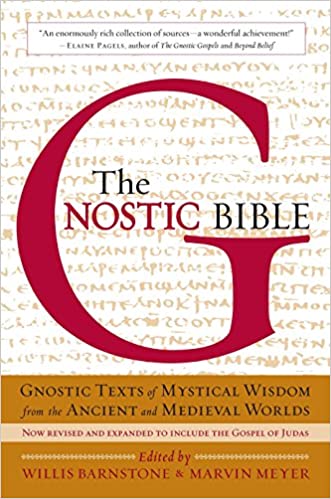 We’ve written about Gnosticism quite a bit — from reading countless books on the Gnostic Scriptures (see our Spring book recommendation write-up) as well as the specific ones which were found in Nag Hamaddi. They included the Gospels of Thomas, Philip, Mary and others. The findings at Nag Hammadi Scriptures (which was based on findings in 1945 in Egypt), were truly profound.
We’ve written about Gnosticism quite a bit — from reading countless books on the Gnostic Scriptures (see our Spring book recommendation write-up) as well as the specific ones which were found in Nag Hamaddi. They included the Gospels of Thomas, Philip, Mary and others. The findings at Nag Hammadi Scriptures (which was based on findings in 1945 in Egypt), were truly profound.
In our Spring write-up, we covered Mark M. Mattison’s books that summarize the individual gospels including the Gospel of what is referred to as Q and the Gospel of Truth. The beautiful thing about his books as they are short reads so you can get a great overview without spending weeks and weeks having to dive through lengthier explanations. What we learn from the Nag Hammadi findings and in Mattison’s books are that the early followers of Jeshua wanted to preserve his legacy and what he was truly about, not what the Church and others portrayed him as for over 2,000 years.
The Gnostic Bible is the complete opposite – it goes deep. At over 800 pages with a lengthy glossary and bibliography, there is plenty to explore. For those who really want to understand the Gnostic Texts from the ancient and medieval worlds, this is a must have — it can be served as a reference guide as well, so you can turn to it for reference for years to come.
Those of you who are familiar with these teachings, you know that they were part of a wide-ranging religious movement of the first millennium CE—with earlier antecedents and later flourishings—whose adherents sought salvation through knowledge and personal religious experience.
Some gnostic texts suggest that god should be celebrated as both mother and father, and that self-knowledge is the supreme path to the divine, which was obviously controversial to the Catholic Church, Judaism and other organized and structured religious orders of the time. Only in the past fifty years has it become clear how far the gnostic influence spread in ancient and medieval religions—and what a marvelous body of scriptures it produced.
The selections gathered here in poetic, readable translation represent Jewish, Christian, Hermetic, Mandaean, Manichaean, Islamic, and Cathar expressions of gnostic spirituality. Their regions of origin include Egypt, the Greco-Roman world, the Middle East, Syria, Iraq, China, and France. Grab it over on Amazon.
Essential Gnostic Scriptures
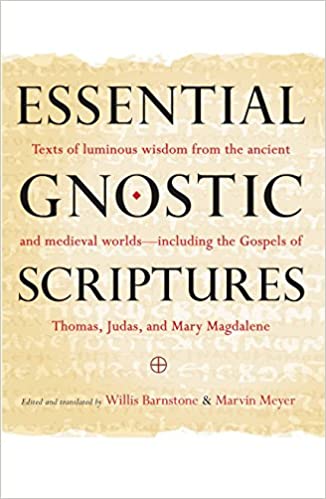 For those of you who don’t have time for 800 pages but would love to get a great overview, check out the Essential Gnostic Scriptures. BTW, Elaine Pagels also has a great book on the Gnostic Gospels — we’ve covered it before and even taught a Study with Spirit class on it.
For those of you who don’t have time for 800 pages but would love to get a great overview, check out the Essential Gnostic Scriptures. BTW, Elaine Pagels also has a great book on the Gnostic Gospels — we’ve covered it before and even taught a Study with Spirit class on it.
As mentioned above, the people we’ve come to call Gnostics (and who believed in what is referred to as the Gnostic teachings) were passionate advocates of the view that salvation comes through knowledge and personal experience — in other words, rather than God being this external force outside of us, it is all available to us through an inward journey and inner knowing.
Willis Barnstone and Marvin Meyer have created a translation that brings the these incredible voices to us from across the centuries starting with texts from the earliest years of Christianity—including material from the Nag Hammadi library (see above)—and continuing all the way up to expressions of gnostic wisdom found within Islam and in the Cathar movement of the Middle Ages.
This book includes twenty-one texts and cover its principal ideas so if you’re not familiar with these gems which were uncovered in the 1940’s, this is a must read. There is so much wisdom and resonance in the Gnostic teachings that regardless of your belief system, there’s something to learn and garner insight from by better understanding the teachings of that time.
For those of you who are not familiar with the light that Mary Magdalene’s wisdom has brought to the modern world with newfound books on her teachings and principles, she was indeed an integral and important part of these Gnostic teachings of the time. See below.
The Essential Gnostic Scriptures is also on Amazon.
The Meaning of Mary Magdalene
This great read by Cynthia Bourgeault is a must for anyone yearning to know more about Mary Magdalene, the mysterious woman who walked by Jesus’ (Jeshua’s) side over 2,000 years ago. Although she is prominent in history and Christian traditions, she didn’t receive the voice and respect she deserved.
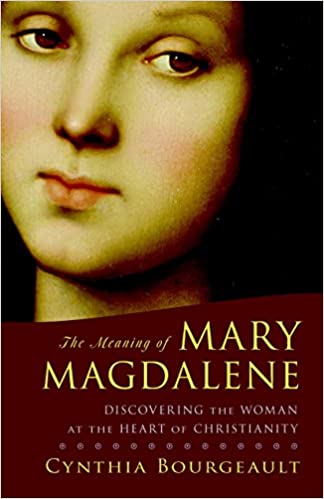 Know that this is far from a new book release, but we feel that Cynthia’s authentic take and work is still not known by masses despite how long she has been on public stages speaking and writing about the heart through Magdalene and other spiritual visionary eyes.
Know that this is far from a new book release, but we feel that Cynthia’s authentic take and work is still not known by masses despite how long she has been on public stages speaking and writing about the heart through Magdalene and other spiritual visionary eyes.
Forward wind the clock since Cynthia’s book was originally published (a decade ago), we are now seeing Mary Magdalene rising as not just one of the most influential symbols in the history of Christianity, but so much more.
Yet, if you look in the Bible, you’ll find only a handful of verses that speak of her. She is in famous paintings over the years, often at the foot of Jesus. She is seen with anointed bottles and she is seen in the backgrounds.
And yet, why did she get so little ink and attention over the years? Given how women were perceived at the time, it is no wonder. She had Jeshua’s ear and the Prophets knew this.
Cynthia asks: “how did she become such a compelling saint in the face of such paltry evidence?” Bourgeault — whose work we love — examines the Bible, church tradition, art, legend, and newly discovered texts to see what’s there.
She then adds her own reasoning and intuition, tapping into of course, the wisdom of the ages-old Christian contemplative tradition. What emerges is a radical view of Mary Magdalene as Jesus’s most important disciple, the one he considered to understand his teaching best. And btw, Cynthia’s insights here aren’t the only ones that reflect how important she was as a teacher, disciple and a revolutionary healer at the time who healed together with Jesus.
Her teachings (as were the teachings of Jesus Magdalene asserts through the Gnostic Gospels) were characterized by a non-dualistic approach to the world and by a deep understanding of the value of the feminine. And, that love is the most important thing in the Universe, the glue if you like that is timeless and always constant.
Cynthia shows how an understanding of Mary Magdalene can revitalize contemporary Christianity, how Christians and others can, through her, find their way to Jesus’s original teachings and apply them to their modern lives. Bravo Bravo — find this great read on Amazon.
Magdalene Mysteries
While we’re on Mary Magdalene whose energy we love, let’s move to a newer release with incredible artwork and illustrations as well as bold language throughout. Meet Magdalene Mysteries by Seren Bertrand and Azra Bertrand M.D. (authors of Womb Awakening as well) who speak to the left-hand path of the feminine Christ. 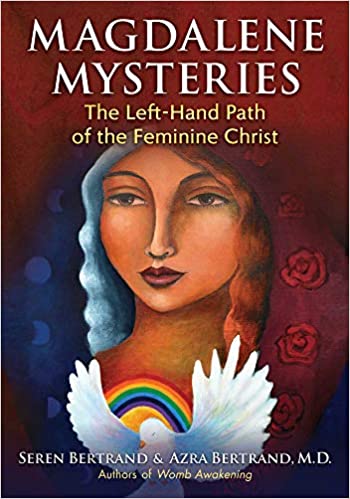
BTW, we’re big believers in reading history and great works more than once, so even if you’ve read Cynthia’s work on Magdalene, read it again AND then pick up Magdalene Mysteries, as it is sure to reshape so much for you as it did for us.
Why? You’ll see a sharp juxtaposition about what we could say acceptably a decade ago versus where we are today in our humanity’s progression. From the Goddess of “Divine Whore” to the pure “Goddess of Love” whom Magdalene represented most, we are taken on a beautiful journey in this book written by the Bertrands.
Other Goddess references are woven in, such as the references (Sumerian) to Inaana/Ishtar — of which celestial, love, and beauty are all part of the equation, Magdalene included.
They reference Hebrew scholar Raphael Patai, Ph.D. from his book “The Hebrew Goddess” which traces the presence of feminine divinity throughout the history of Judaism. In the time of Mary Magdalene and Jesus, he writes….”the temple of Jerusalem contained a golden statue of two naked cherubim entwined in sexual embrace, symbolizing the esoteric Jewish mystery tradition: the hidden power of the goddess and mystical participation in the bridal chamber rites that secretly rest at the root of the religion.
“It is only when the masculine and feminine principles come together — in both human and divine form — that the Kabbalistic Tree of Life is fertilized and renewed.” In the same section, we hear more about the importance of these symbols in Judaism history: “that over time, the two cherubim began to symbolize the unification of masculine and feminine energies on the Tree of Life.”
Hear hear. Enuf said. We have been so out of balance in our society for so long, that returning to ancient wisdom is long overdue. Grab this incredible read over on Amazon.
The Sacred Herbs of Spring
As we’re moving into Summer, our gardens are in full swing, right? This book focused on the herbs of the season, now ready to be used is a great way to learn how we can use the magic of the Earth to heal.
 Let’s face it, there are so many edible plants and over time, humanity has forgotten the healin nature of the Earth herself and that so much can be garnered from our own backyards.
Let’s face it, there are so many edible plants and over time, humanity has forgotten the healin nature of the Earth herself and that so much can be garnered from our own backyards.
This lovely read by Ellen Evert Hopman (who is also the author of the Sacred Herbs of Samhain, a ritual we practice every year), speaks about the time for magic and spells for increasing the fertility of the land and the plants which of course, change by season.
The author dives into the Gods and Goddesses of Spring, preparing us of course for Summer. We learn about the rituals, the seasonal magic, the prayers, poems, incantations, and more.
We learn about more than 70 herbs and trees, all with recipes, meaning and understanding so we can tap into their powers for healing and holistic living. There are herbs from everything ranging from luck, magic, purification and abundance to love, protection, and more.
Don’t believe in Fairies and Elves? Think again. Woven beyond and among so many histories and cultural traditions, we learn to honor what we know within, and from the land even if it appears to be wacky or ‘out there’ by some. Honor that inner knowing — honor Gaia’s wisdom and in doing so, you’ll open yourself up to so much magic beyond our linear thinking and understanding.
Learn from Hopman, who is a mater herbalist, homeopath and a long time Druidic initiate. Find tihs great read over on Amazon as well.
Spiritual Symbols Workbook
Here’s what we loved about this find: this experiential book brings you into a process that opens your heart. 
In this authentic and creative workbook, rather than listen to symbols which may work, you have the opportunity to create your own dictionary of Spirit’s signs and symbols. In other words, as they come up, you jot them down and can return to your notes so you can ignite your spiritual awakening and go at your own pace, with your own notes and interpretations rather than someone else’s.
Led by Light
Also by Rev. Joanna Bartlett is a short and handy read called Led by Light, which is essentially a guide to develop your own intuitive mediumship abilities.

We tell people all the time as do the guides we channel: we all have the ability to bring forth energies and messages from higher dimensions.
The truth is that we all get insights and intuitions, but how often do we actually act upon what we hear, know and see? Often people get these messages or have these inner knowings, but feel either intimidated by them, don’t trust them or feel a little frightened.
Whether you see and sense Spirit and don’t know how to deal with it, or think you might be able to but need a little guidance, Bartlett’s down-to-earth guide provides a foundation for the innate “tapping into the other side” intuitive abilities that humanity all has access to if they choose to go there.
She includes things like: how communication with Spirit works, how to safely open yourself up with intention and boundaries, meditation exercises, how to raise your vibration while also stay grounded, how to connect to your intuitive abilities and more.
She also helps you develop a relationship with your spirit guides and learn to understand the meaning behind the symbols and signs you may be receiving on a regular basis.
You can grab this great read over on Amazon.
The Holy Trinity and the Law of Three
Also by Cynthia Bourgeault is this fascinating read that explores the radical truth at the heart of Christianity.
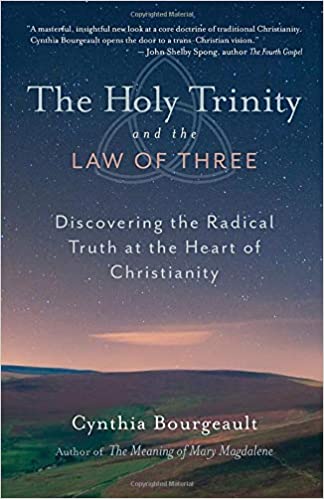
Just as she’s done in her previous books, Cynthia Bourgeault asks us to take a look at an idea from traditional Christianity—this time the formula of Father, Son, and Holy Spirit—as though we’re looking at it for the first time.
I love Cynthia’s boldness – she is brave enough to go deep and really ask us to truly reflect and understand what reality is — what is the truth? In this book, she finds in the idea of the Holy Trinity a striking vision of the nature of reality.
What she claims is that embedded within this theological formula that Christians recite mostly on autopilot lies a powerful metaphysical principle that could change our understanding of Christianity and give us the tools so long and so sorely needed to reunite our shattered cosmology, rekindle our visionary imagination, and cooperate consciously with the manifestation of Jesus’s “Kingdom of Heaven” here on earth.
Back to the Gnostic teachings again above, which looks at and honors/embraces the idea of equal divine feminine and divine masculine in all things — in humanity, in Gaia, and yes in GOD.
She so beautifully weaves in Christian theology and relates it to her own years of contemplative practice, as well as to the ideas of G. I. Gurdjieff.
She writes, “my commitment is to getting there, because I know beyond all personal doubt that there is indeed a ham radio concealed inside this Trinitarian tea cupboard. And in the midst of this long winter of our Christian discontent, when spiritual imagination and boldness are at an all-time low and the church itself hovers at the edge of demise for lack of an animating vision, perhaps now more than ever the time is ripe to remove the packing boards from this tea cupboard and release its contents.”
All of her work is powerful so regardless of what speaks to you about her books, you’ll have a wonderful ride into insights you perhaps didn’t expect. Her rawness yet beautiful and approachable way she delivers content is wondrous. Find The Holy Trinity and the Law of Three over on Amazon. Also take a look at another of her reads called The Heart of Centering Prayer – Nondual Christianity in Theory and Practice. All of her work is worth reading.
Rumi’s World
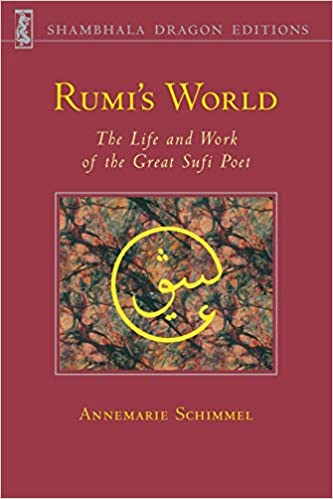 Back to Rumi again because why not? Who can’t get enough of Rumi. This great book on Rumi by Annemarie Schimmel covers the Life and Work of the Great Sufi Poet which btw was apparently previously published as I Am Wind, You Are Fire.
Back to Rumi again because why not? Who can’t get enough of Rumi. This great book on Rumi by Annemarie Schimmel covers the Life and Work of the Great Sufi Poet which btw was apparently previously published as I Am Wind, You Are Fire.
Schimmel covers the story of his life, along with an enlightening examination of his ecstatic verse and its hard to tire of any of it. Even if you’re not a Rumi fan or new to his work, you’ll be riveted by the simplistic and yet profound teachings through his poetry and phrases/quotes.
From Anatolia, he taught — considered a spiritual teacher and did that quietly until the age of thirty-seven, when he came under the influence of a whirling dervish, Shams Tabriz, and was moved to a state of mystical ecstasy. Alas, transformation happened as it does with all of us who dare to go deep within, the hardest practice and commitment of all.
For within, forces us to deal with our shadows and the hard stuff. It is here where the freedom comes however.
To symbolize this search, Rumi also invented the famous whirling dance of the Melevi dervishes, which are performed accompanied by the chanting of Rumi’s poems. The author includes some of her own translations of some of his most famous poems — simply put, you won’t want to put it down.
Those new to her work, Annemarie Schimmel is an international authority on Islamic religion and literature. She has authored over 70 books (yes, really) and lectures worldwide on the topic.
You can grab Rumi’s World on Amazon.
Sufism: An Introduction to the Mystical Tradition of Islam
 Sufism is often referred to as the mystical tradition or side of Islam. Not everyone agrees with this of course, but it has been practiced around the world in Islam countries and non-Islam countries — from Morocco to India to China—and it is said to be as varied as their distinctive forms of art, music, poetry, and dance. As noted by the author, Sufism is notoriously difficult to define, as it means different things to different people both within and outside the tradition.
Sufism is often referred to as the mystical tradition or side of Islam. Not everyone agrees with this of course, but it has been practiced around the world in Islam countries and non-Islam countries — from Morocco to India to China—and it is said to be as varied as their distinctive forms of art, music, poetry, and dance. As noted by the author, Sufism is notoriously difficult to define, as it means different things to different people both within and outside the tradition.
This wonderful take on Sufism by Carl Ernst explores the broadest range of Sufi philosophies and practice, tracing the history of the movement from the earliest days of Islam to the present day.
He points out (and writes) that “Muslim theology works largely from the names of God as the primary givens from which extrapolations may be made. God’s Essence is forever unknowable and transcendent. But his names designates the attributes which are the intelligible aspects that constitute the world.”
Ernst also explains Sufism in the context of the larger world of Islam and its encounters with both fundamentalism and secularism in the modern world.
You can find this great read on Amazon as well.
Healing Courses & Books by Shelley A. Kaehr Ph.D.
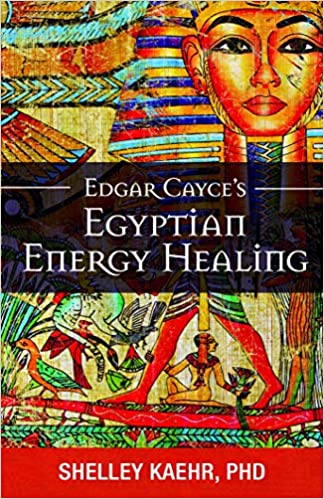 We fell upon the work of Shelley A. Kaehr who teaches healing methods she has learned over the years, including Pythagorean Healing (Levels 1, 2 and 3), Egyptian Healing (from Edgar Cayce Methods), and Galactic Healing as well.
We fell upon the work of Shelley A. Kaehr who teaches healing methods she has learned over the years, including Pythagorean Healing (Levels 1, 2 and 3), Egyptian Healing (from Edgar Cayce Methods), and Galactic Healing as well.
First of all, we love Shelley’s energy and it was her authenticity which initially drew us into her amazing work. She cares about what she does and teaches and it shows in everything she does.
Her Egyptian healing methods involve Egyptian symbols based on the work of renowned Edgar Cayce and through her books and teachings, she teaches you how to use these symbols to heal yourself and others. In other words, we learn about Edgar Cayce’s Egyptian Energy Medicine. Profound in a myriad of ways, she guides you in the process so you too can use them to empower your own work, whether you’re a healing practitioner already or are simply curious. 
Her books on Pythagorean Healing connect to the Sacred Geometry of numbers and how to use them in binary form and together with colors and meaning (emotions), so you can use them in your work with others, whether its for the intention of emotional healing, physical or a combination of both.
Her work is aimed at helping people use these symbols to bring more balance and peace into your life and create more alignment than you perhaps have today. She even shares the modalities and teachings she has received from her guides with binary numbers and how to incorporate them into your life in a way that creates more harmony and balance.
Find her books over on Amazon. Binary Healing can be found here and Platonic Healing can be found here. Discover her Egyptian healing book here. Find out more about her courses on her website.
Bottoming Out the Universe
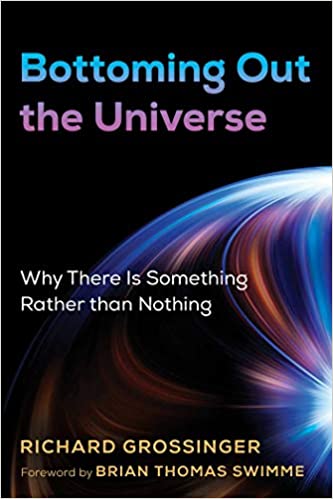 This absolute riveting read with a foreward by Brian Thomas Swimme (who we have seen speak live at various events over the past two years) begs you to read more, page after page.
This absolute riveting read with a foreward by Brian Thomas Swimme (who we have seen speak live at various events over the past two years) begs you to read more, page after page.
The book draws on transdimensional physics and biology, reincarnation and past-life memories, animal consciousness, multiple identities, thoughtforms, soul pictures, and paranormal phenomena like crop circles and poltergeists.
While not an academic read, it’s not a ‘new age’ one either. Nothing about the book feels that way, from his references to science and respected researchers throughout to all the ways he draws parallels to traditional thinking and philosophy.
Although he challenges traditional scientific orthodoxy views, he doesn’t dismiss them either. That said, he weaves you into a more profound way of thinking about Consciousness and the Universe itself.
Like our buddy Mark Gober does in his book, “An End to Upside Down Thinking” Grossinger talks about consciousness outside the brain as well as where the nature of reality comes from — he offers a wide-ranging foundation for reimaging the universe as based in consciouness rather than matter.
He also explores the riddle of personal identity and how it differs from consciousness as well how consciousness is so much more than what it appears. We dive into questions like: “how did consciousness become part of the material universe? Is it a by-product of brain chemistry or a constituent of reality? Or, to dig deeper, which is more fundamental: the existence of an objective physical universe or our subjective experience of it?”
He also examines concepts from physics that combine elements of both consciousness and matter, such as collapsing waveforms and the uncertainty principle of quantum mechanics. Examining non-local and transpersonal modes of consciousness, Grossinger looks at the difference between consciousness and personal identity.
Find this incredible read on Amazon. This book was so good that I plan to read it again.
The Religion of Tomorrow
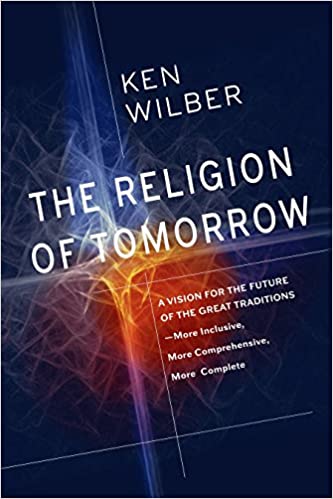 This in-depth read by renowned Ken Wilber explores a vision of the religion of tomorrow. Many of us may have pondered this aspect – what will the belief systems of many be tomorrow? Will they merge or become more separate?
This in-depth read by renowned Ken Wilber explores a vision of the religion of tomorrow. Many of us may have pondered this aspect – what will the belief systems of many be tomorrow? Will they merge or become more separate?
There is so much diversity among religions and yet he asserts: a single purpose lies at the heart of all the great religious traditions: awakening to the astonishing reality of the true nature of ourselves and the universe. In other words, this core insight has become obscured.
In the beautiful way that Ken Wilber always does, he provides a path for re-envisioning a religion of the future that acknowledges the evolution of humanity in every realm while remaining faithful to that original spiritual vision.
For the traditions to attract modern men and women, Wilber asserts, “they must incorporate the extraordinary number of scientific truths learned about human nature in just the past hundred years—for example, about the mind and brain, emotions, and the growth of consciousness—that the ancients were simply unaware of and thus were unable to include in their meditative systems.”
Wilber uses various examples, including Buddhism, which demonstrates how his comprehensive Integral Approach—which is already being applied to several world religions by some of their adherents—can avert a “cultural disaster of unparalleled proportions”: the utter neglect of the glorious upper reaches of human potential by the materialistic postmodern worldview.
You can order this over on Amazon. Also be sure to check out Grace & Grit, which is a love story by Ken Wilber. He cites it as a spiritual journey through life, loss and beyond and it has apparently been made into a major motion picture as well.
This Ken Wilber narrative shares his five-year journey with his wife, Treya Killam Wilber, through Treya’s illness, treatment, and death. He explores and talks about his approach to the illness they went through together and how to find wisdom in pain—all of which combines wellness, healing, wholeness, harmony, suffering and surrender. Find it over on Amazon.
The Book of Altars & Sacred Spaces
Anyone who resonates with Pagan traditions regardless of your history and background, will love this new little book focused on altars and sacred spaces.
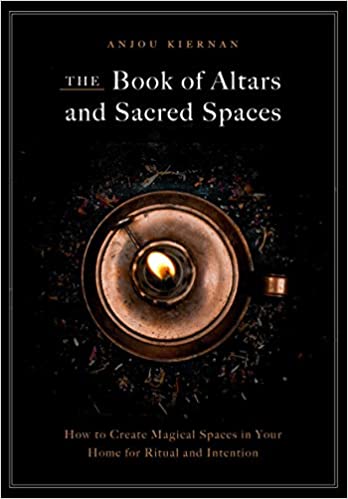 The Book of Altars and Sacred Spaces shows you how to create over 50 magical spaces whether its in your home, office or even outside space.
The Book of Altars and Sacred Spaces shows you how to create over 50 magical spaces whether its in your home, office or even outside space.
Author Anjou Kiernan walks you through various ways to create altars and sacred spaces based on the Wheel of the Year and all of these beautiful and holidays that many of us follow.
One of the most beautiful things about this book is the artistry woven throughout, giving you creative and playful ways to craft and curate sacred and honoring spaces around specific times of the year and events that follow the seasons, such as the infamous Samhain as an example.
Many may be familiar with Samhain but what about some of the more obscure ones that we don’t know about, like Beltane. I hadn’t heard of this one. For each reference, we are given alternative names, the colors associated with it, crystals you can use, the deities connected to it, the element (aka, air, fire, earth and so on), the various flowers you can use, foods, symbols and themes.
Each one includes all of them as well as beautiful images to get your creative juices flowing. So, whether its the Spring Equinox, Lughnasadh (the gateway to the darker half of the year — the cross-quarter holiday between Midsummer and Autumn Equinox), or what’s referred to as the Celtic celebration Imbolc, you will be taken on a magical journey that celebrates various times of the year.
This book will give you countless ideas, whether it is to build a sacred fire pit for Beltane or Feast Table for the Autumn Equinox, the book helps you learn how to honor the sacred doorways of the year and bring magic into your daily life. We love it!
Grab this visually exciting book over on Amazon.

Renee Blodgett is the founder of We Blog the World. The site combines the magic of an online culture and travel magazine with a global blog network and has contributors from every continent in the world. Having lived in 10 countries and explored over 90, she is an avid traveler, and a lover, observer and participant in cultural diversity. She is also the founder of the Magdalene Collection, a jewelry line dedicated to women’s unsung voices and stories, and the award-winning author of the bestselling book Magdalene’s Journey
She is founder of Blue Soul Media and co-founder of Blue Soul Earth as well as the producer and host of the award-winning Blue Soul CHATS podcast, that bridges science, technology and spirituality. Renee also founded Magic Sauce Media, a new media services consultancy focused on viral marketing, social media, branding, events and PR. For over 20 years, she has helped companies from 12 countries get traction in the market. Known for her global and organic approach to product and corporate launches, Renee practices what she pitches and as an active user of social media, she helps clients navigate digital waters from around the world. Renee has been blogging for over 16 years and regularly writes on her personal blog Down the Avenue, Huffington Post, BlogHer, We Blog the World and other sites. She was ranked #12 Social Media Influencer by Forbes Magazine and is listed as a new media influencer and game changer on various sites and books on the new media revolution. In 2013, she was listed as the 6th most influential woman in social media by Forbes Magazine on a Top 20 List.
Her passion for art, storytelling and photography led to the launch of Magic Sauce Photography, which is a visual extension of her writing, the result of which has led to producing six photo books: Galapagos Islands, London, South Africa, Rome, Urbanization and Ecuador.
Renee is also the co-founder of Traveling Geeks, an initiative that brings entrepreneurs, thought leaders, bloggers, creators, curators and influencers to other countries to share and learn from peers, governments, corporations, and the general public in order to educate, share, evaluate, and promote innovative technologies.








